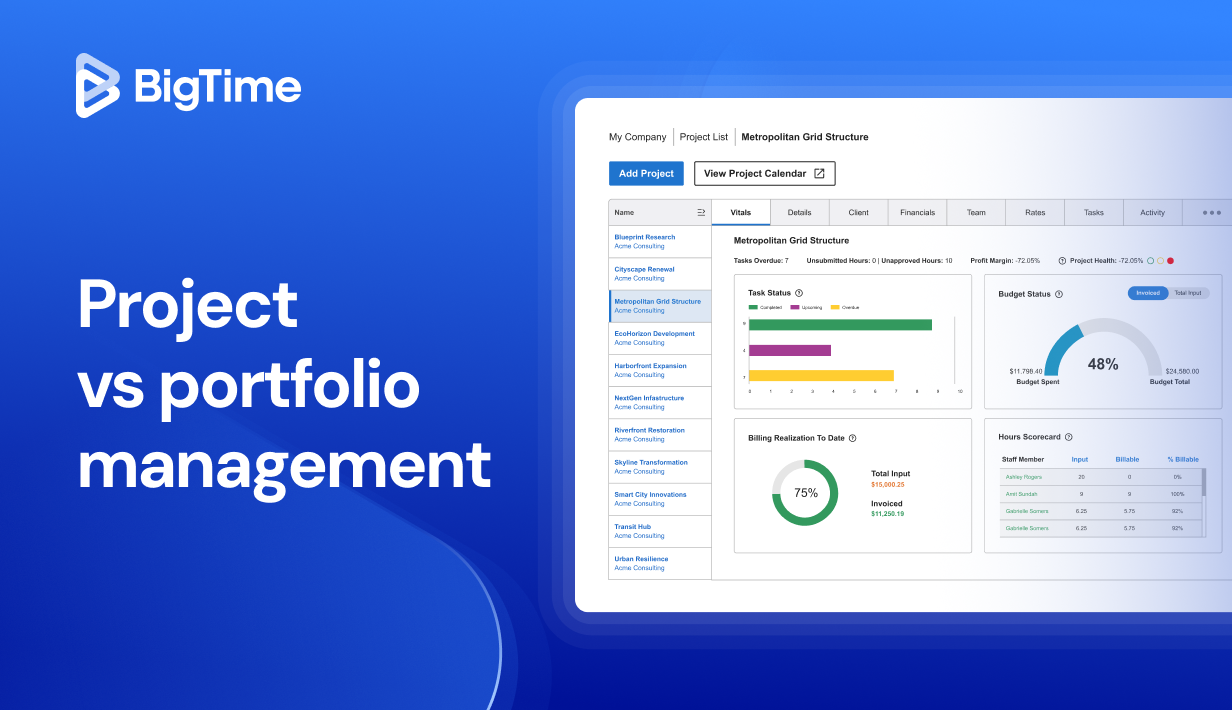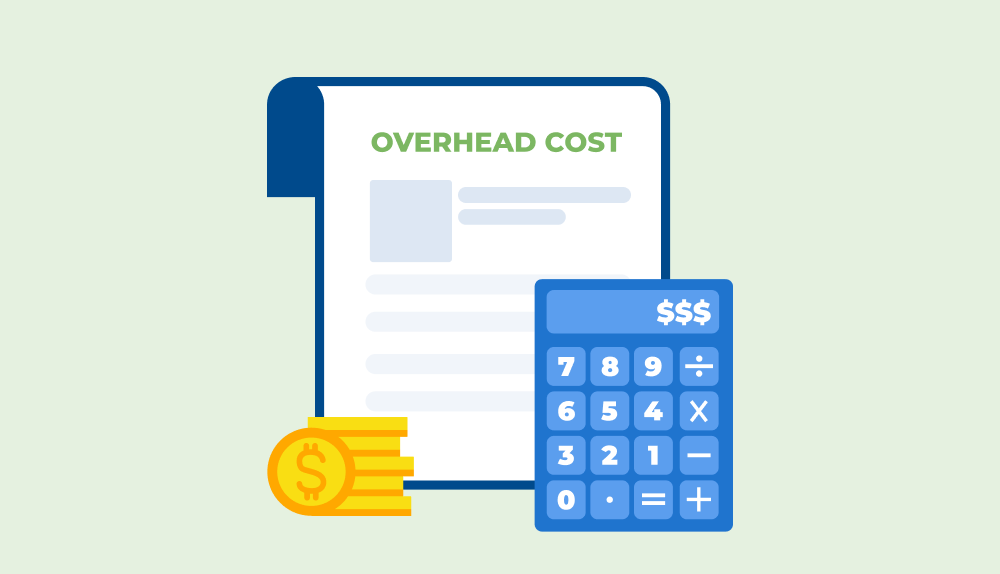Understanding the difference between program, portfolio and project management is critical for every professional services company aiming to achieve its strategic objectives while maintaining long-term business growth.
While the concepts are often confused or used interchangeably, they serve distinct purposes. Still, project and portfolio management with elemens of program management provide a complete system for execution and strategy, ensuring not only that particular project succeeds, but also that they align with organizational goals.
This guide breaks down the essentials of project management, program management, and project portfolio management, highlights the key differences, and shows how the three functions combine to create a stronger framework for performance and scalability in multiple projects at once.
What is a “project” in project management?
In the context of project and portfolio management, a project is defined as a temporary and goal-oriented effort undertaken to create a unique product, service, or outcome. Unlike routine operations, individual projects have a clearly defined start and finish, measurable project objectives, and specific deliverables. Each project is designed to achieve a set of outcomes within agreed constraints such as time, budget, and scope.
What is a “program” in program management?
In project management, a program is a coordinated group of related projects managed together to achieve benefits that wouldn’t be possible if they were handled individually. Unlike a single project, which has a defined outcome, or a portfolio, which is strategy-driven, programs focus on delivering broader business benefits and reach strategic goals by linking multiple projects under one umbrella.
For example, a digital transformation program might include separate projects for software development, employee training, and infrastructure upgrades. By managing them as a program, organizations ensure alignment, reduce risks, and capture synergies across all related initiatives.
What is a “portfolio” in portfolio management?
In the broader framework of portfolio and project management, a portfolio is a collection of projects and programs grouped together to achieve strategic business objectives. While a single project focuses on delivering a specific outcome, a portfolio aligns multiple projects to ensure they collectively support the company’s long-term goals.
Thanks to their comprehensive nature, project portfolios help leaders make informed decisions about resource allocation, prioritization, and risk management, as well as other key project management processes. By overseeing an entire portfolio, managers can balance short-term project success with long-term strategic growth, creating a business strategy for months and years to come.

Project vs program vs portfolio management
Although project management and portfolio management are closely connected, they operate at different levels within an organization. Project management focuses on the tactical side, or delivering a single project successfully by managing scope, schedule, costs, and quality while supporting project teams. In contrast, project portfolio management focuses on organization’s strategies, ensuring that all projects and programs are aligned with organizational priorities, enabling leaders to make the most of human and financial resources. Between the two lies program management, which acts as a crucial link. It provides oversight, coordination, and governance across projects that share common objectives.
Think of it this way:
- Project management is about “doing things right” and ensuring each project is delivered successfully.
- Program management is about “realizing benefits”, orcoordinating related projects to deliver greater value collectively.
- Portfolio management is about “choosing the right things to do”, or deciding which projects and programs should be prioritized to drive long-term business strategy.
| Aspect | Project Management | Program Management | Project Portfolio Management |
| Definition | A temporary initiative with a defined scope, timeline, and deliverables. | A coordinated group of related projects managed together for added benefits. | A collection of projects and programs managed to achieve strategic business goals. |
| Primary Focus | Delivering a unique outcome within time, budget, and scope. | Achieving benefits and efficiencies by aligning multiple projects. | Ensuring all projects and programs align with long-term organizational strategy. |
| Timeframe | Short-term, with a clear start and finish. | Mid- to long-term, evolving as projects progress. | Continuous and ongoing. |
| Scope | Narrow—focused on a single project’s success. | Broader—manages interrelated projects to deliver combined outcomes. | Broadest—manages all projects and programs under an organization’s umbrella. |
| Management Level | Tactical: handled by project managers. | Tactical + Strategic: managed by program managers coordinating multiple projects. | Strategic: overseen by portfolio managers and executives. |
| Success Criteria | Completion on time, within budget, and at the desired quality. | Delivery of combined benefits, improved coordination, and reduced risks across projects. | Maximizing ROI, strategic alignment, and business value creation. |
What is a project manager?
A project manager is the person responsible for planning, executing, and delivering individual projects successfully. Their role is primarily operational, focusing on ensuring that the project stays within budget, meets deadlines, and delivers the expected quality. Project managers act as a bridge between clients, stakeholders, and project teams, translating strategic objectives into actionable steps.
Project manager – key responsibilities
A project manager’s responsibilities cover all aspects of project execution, from planning to closure. Their main goal is to keep the project on track while managing resources and expectations. To do so, project managers focus on:
- Defining project scope and objectives. The project manager outlines what the project is meant to achieve, ensuring all project deliverables are clear and aligned with client requirements.
- Creating detailed project plans. They develop schedules, assign tasks, and build project timelines that guide the team through each stage of the project lifecycle.
- Managing resources. Effective allocation of people, tools, and budgets is essential. Project managers ensure that the right resources are assigned to the right tasks at the right time.
- Monitoring progress. Using performance tracking and reporting tools, project managers measure actual results against the plan and make adjustments when deviations occur.
- Project closure and evaluation. Once the project ends, they conduct project evaluations to capture lessons learned and ensure smooth handover of deliverables.
What is a program manager?
In professional services companies, a program manager oversees a collection of related projects that are grouped together under a single program. Unlike project managers, who focus on the success of individual projects, program managers ensure that all interconnected projects work in harmony to deliver greater business benefits. Their role is both strategic and tactical: they maintain alignment with organizational goals while managing interdependencies, risks, and resource allocation across multiple projects.
Program manager – key responsibilities
Program managers carry broader responsibilities than project managers, as they must manage multiple projects simultaneously while focusing on long-term benefits. Their core responsibilities include:
- Coordinating interrelated projects. They manage dependencies between projects, making sure that each achieves key milestones and contributes to overall program goals without causing delays or conflicts.
- Managing resources across projects. Unlike project managers who focus on a single team, program managers balance resources across multiple projects to optimize efficiency and minimize conflicts.
- Monitoring overall program performance. They track progress at a higher level, ensuring that all projects are on schedule, within budget, and aligned with expected benefits.
- Risk management at the program level. Program managers anticipate and mitigate risks that could affect multiple projects, ensuring continuity and stability.
- Delivering business benefits. The ultimate responsibility of a program manager is to ensure that the combined outcome of all projects delivers measurable improvements in performance and value.
What is a portfolio manager?
A portfolio manager is responsible for overseeing the organization’s entire collection of projects and programs to ensure they align with long-term strategic goals. Unlike project managers, who focus on execution, or program managers, who coordinate related projects, portfolio managers operate at the highest strategic level. Their primary focus is on maximizing return on investment (ROI), prioritizing initiatives, and balancing risks across the organization’s portfolio.
Within the framework of portfolio and project management, the portfolio manager evaluates which projects and programs should move forward, which should be paused, and how resources should be allocated to achieve the greatest business impact. Their decisions directly influence company growth, profitability, and competitiveness.
Portfolio manager – key responsibilities
The role of a portfolio manager goes beyond delivering individual outcomes; it is about guiding the organization’s entire investment in projects and programs. Their responsibilities typically include:
- Aligning portfolios with business strategy. Portfolio managers ensure that every project and program supports the company’s long-term objectives and provides measurable value.
- Prioritizing projects and programs. They evaluate competing initiatives and decide which ones should move forward based on strategic importance, resources, and expected ROI.
- Resource allocation at scale. Unlike project or program managers, portfolio managers monitor resource availability and distribute resources across the entire organization, balancing capacity and demand.
- Monitoring portfolio performance. They track financial and strategic performance metrics to assess whether the overall portfolio is delivering on expected outcomes.
- Optimizing overall business value. The portfolio manager’s ultimate responsibility is to ensure that the organization’s combined projects and programs deliver the highest possible value.
Project vs program vs portfolio manager: comparison
Although the titles sound similar, project managers, program managers, and portfolio managers play very different roles in professional services companies. We compare them in a table below.
| Aspect | Project Manager | Program Manager | Portfolio Manager |
| Primary Focus | Delivering a single project on time, within scope and budget. | Coordinating multiple related projects to deliver combined benefits. | Overseeing all projects and programs to ensure strategic alignment and ROI. |
| Level of Work | Tactical – daily operations and task management. | Tactical + Strategic – balancing project execution with program-level outcomes. | Strategic – investment decisions, prioritization, and portfolio performance. |
| Timeframe | Temporary – tied to the duration of a project. | Mid- to long-term – evolves as projects progress under the program. | Continuous – ongoing oversight of all organizational initiatives. |
| Resource Focus | Allocates resources to a single project. | Balances resources across multiple projects within a program. | Optimizes resources across the organization’s full portfolio. |
| Success Criteria | Deliverables completed on time, within budget, and at the required quality. | Program benefits realized, risks minimized, and projects working in harmony. | Portfolio ROI, strategic alignment, and maximized business value. |
| Stakeholder Role | Reports to program managers or executives. | Coordinates between project managers and senior leadership. | Advises executives and shapes organizational strategy. |
How do program, portfolio and project management combine?
While project management, program management, and portfolio management serve different purposes, they are deeply interconnected.
At the most granular level, project management ensures that individual projects are delivered on time, within budget, and according to quality expectations. Stepping up one level, program management connects multiple related projects under a single umbrella. Finally, project portfolio management takes a strategic perspective, overseeing all projects and programs across the organization.
When combined, these three disciplines—project, program, and portfolio management—create a comprehensive system often referred to as PPM (project and portfolio management). By integrating tactical execution with strategic oversight, companies gain full visibility into progress, risks, and value, enabling them to make smarter, data-driven decisions at every level.
Managing projects and portfolio? Use BigTime
Both project management and portfolio management are essential for business success. Too often, companies treat them as separate processes, failing to obtain benefits crucial for the success of their business. In reality, portfolio and project management should be managed together within one integrated system.
That’s exactly what BigTime offers. As a leading professional services automation platform, BigTime brings together the tactical execution of project management and the strategic oversight of portfolio management in a single solution. This combination helps organizations gain visibility across all levels of work, from day-to-day tasks to company-wide performance.
BigTime Features for Project and Portfolio Management
- Project Scheduling and Timelines. Build precise project plans with Gantt charts, timelines, and automated scheduling that keep every initiative on track.
- Resource Allocation Across Projects. Assign the right people to the right tasks across multiple projects and portfolios, minimizing conflicts and maximizing utilization.
- Budgeting and Financial Tracking. Monitor project costs, overheads, and profitability in real time, while aligning budgets with overall portfolio targets.
- Performance and Progress Monitoring. Track KPIs such as utilization rates, milestone achievement, and ROI across projects and programs.
- Advanced Reporting and Dashboards. Generate customizable reports at both the project and portfolio level, providing insights for managers and executives.
- AI-Powered Forecasting. Predict resource needs, financial outcomes, and project risks with AI-driven analytics that support smarter decision-making.
By uniting execution and strategy, BigTime ensures that no project operates in isolation. Instead, every initiative contributes to the bigger picture of organizational growth and profitability.
Ready to see BigTime in action? Book a demo today and discover how it can transform the way you manage projects and portfolios.




